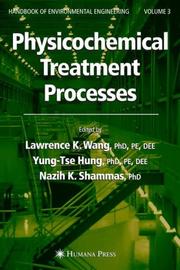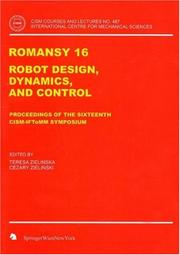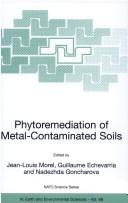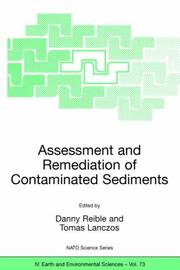| Listing 1 - 10 of 109 | << page >> |
Sort by
|
Book
ISSN: 07246145 ISBN: 9783642149955 9783642149948 3642149944 Year: 2010 Volume: 122 Publisher: Berlin, Heidelberg Springer Berlin Heidelberg
Abstract | Keywords | Export | Availability | Bookmark
 Loading...
Loading...Choose an application
- Reference Manager
- EndNote
- RefWorks (Direct export to RefWorks)
Past, Present, and Future Industrial Biotechnology in China, by Zhenjiang Li, Xiaojun Ji, Suli Kan, Hongqun Qiao, Min Jiang, Dingqiang Lu, Jun Wang, He Huang, Honghua Jia, Pingkai Ouyuang, and Hanjie Ying; Organic Chemicals from Bioprocesses in China, by Jin Huang, Lei Huang, Jianping Lin, Zhinan Xu, and Peilin Cen; Biofuels in China, by Tianwei Tan, Jianliang Yu, Jike Lu, and Tao Zhang; Bioreactors and Bioseparation, by Siliang Zhang, Xuejun Cao, Ju Chu, Jiangchao Qian, and Yingping Zhuang; Environmental Biotechnology in China, by Shuang Jiang Liu , Lei Liu , Muhammad Tausif Chaudhry , Lei Wang , Ying Guang Chen , Qi Zhou , He Liu , and Jian Chen; Traditional Chinese Biotechnology, by Yan Xu , Dong Wang , Wen Lai Fan , Xiao Qing Mu, and Jian Chen; Modern Biotechnology in China, by Qing-Zhao Wang and Xue-Ming Zhao
Chemistry. --- Biotechnology. --- Renewable and Green Energy. --- Environmental Engineering/Biotechnology. --- Renewable energy sources. --- Chimie --- Biotechnologie --- Energies renouvelables --- Chemistry --- Biotechnology --- Renewable energy sources

ISBN: 9781588291653 1588291650 9781592598205 9786610358229 128035822X 159259820X Year: 2005 Publisher: Totowa, N.J. : Humana Press,
Abstract | Keywords | Export | Availability | Bookmark
 Loading...
Loading...Choose an application
- Reference Manager
- EndNote
- RefWorks (Direct export to RefWorks)
Many human activities-and industrial production in particular-require enormous quantities of clean water and, at the same time, produce enormous quantities of wastes and pollution that require the development of major physical-chemical technologies, processes whose implementation and costs must be justified by the degree of treatment achieved. In Physicochemical Treatment Processes, Volume 3 of the Handbook of Environmental Engineering, a panel of practicing professional engineers and respected educators critically survey both the principles and practices involved in water pollution control, potable water treatment, water reuse, and sludge treatment. The authors discuss the performance, potential, and limitations of each major physicochemical treatment process in detail-including the physical and chemical theory behind it, the applications, the design procedures, examples, references, and cost data-as a basis for intelligent planning and realization of abatement systems. Among the processes covered are screening, comminution, flow equalization, neutralization, mixing, coagulation, flocculation, chemical precipitation, oxidation, recarbonization, softening, halogenation, and disinfection. Additional chapters discuss ozonation, electrolysis, sedimentation, dissolved air flotation, gravity filtration, granular activated carbon adsorption, and sludge treatment. The emphasis throughout is on developing the necessary engineering from fundamental principles of chemistry, physics, and mathematics. Two companion volumes, Air Pollution Control Engineering, Volume 1, and Advanced Air and Noise Pollution Control, Volume 2, survey the basic air pollution control techniques and the use of multiple techniques to deal with air, thermal, and noise pollution. Cutting-edge and highly practical, Physicochemical Treatment Processes, Volume 3 offers educators, students, and practicing engineers a strong grounding in the principles of this critical field, as well as effective methods for developing optimal physical-chemical technologies at costs that are fully justified by the degree of treatment achieved.
Water --- Sewage --- Eau --- Eaux usées --- Purification. --- Epuration --- Purification --- Afvalverwerking --- Sewage -- Purification. --- Water -- Purification. --- Civil & Environmental Engineering --- Earth & Environmental Sciences --- Engineering & Applied Sciences --- Environmental Sciences --- Environmental Engineering --- Afvalverwerking. --- Effluent treatment --- Purification of sewage --- Sewage treatment --- Water treatment --- Purification of water --- Water purification --- Disinfection --- Environment. --- Environment, general. --- Sanitation --- Water quality management --- Water-supply

ISBN: 9783211389270 3211360646 9783211360644 321138927X Year: 2006 Publisher: Vienna : Springer Vienna : Imprint: Springer,
Abstract | Keywords | Export | Availability | Bookmark
 Loading...
Loading...Choose an application
- Reference Manager
- EndNote
- RefWorks (Direct export to RefWorks)
The aim of this publication is to present the research results in robotics that are now state-of-the-art, and indicate the possible future lines of development. To effectively work and cooperate with us, robots must exhibit abilities that are comparable to those of humans. The book describes the ongoing efforts to design and develop human-friendly robotic systems that can safely and effectively interact and work with humans.
Engineering. --- Engineering Design. --- Engineering design. --- Ingénierie --- Conception technique --- Mechanics. --- Robotics. --- Civil & Environmental Engineering --- Engineering & Applied Sciences --- Civil Engineering --- Robotics --- Robots --- Automata --- Automatons --- Manipulators (Mechanism) --- Mecha (Vehicles) --- Design, Engineering --- Engineering --- Industrial design --- Strains and stresses --- Design

ISBN: 9781402056932 1402056915 9781402056918 1402056923 9786610817283 1280817283 1402056931 Year: 2007 Volume: v. 76 Publisher: Dordrecht Springer
Abstract | Keywords | Export | Availability | Bookmark
 Loading...
Loading...Choose an application
- Reference Manager
- EndNote
- RefWorks (Direct export to RefWorks)
Environmental biotechnology, which was in its infancy in the early 80's, has evolved thanks to the revolution brought about by molecular biology. Multiple successes in the biological cleanup of civil and industrial wastewater and of hydrocarbon soil pollution, demonstrate the vast power of clean technologies. In addition, the buildup of information on the activities of microorganisms as catalysts in all sorts of natural, industrial and animal environments has flourished. There is a continuing realization of the critical role of microbial processes in biological, industrial and geological systems. Since environmental biotechnology has matured, it is ready to tackle bigger challenges: the scaling up of many bioremediation systems still in progress, the search for novel biocatalysts for industrial applications, the continuing effort against common human life-threatening processes such as antibiotic resistance, the accumulation of hormone-mimicking substances (endocrine disrupters), the deposition of air-borne pesticides in the environment and, the degradation of recalcitrant contaminants. These endeavors will help prevent the contamination of food chains, protect human life and allow for human activity and economic development that do not compromise environmental sustainabijity. This volume includes the key lectures and participants' contributions delivered at the NATO-funded Advanced Research Workshop (NATO- ARW No. 980838) Bioremediation of Soils Contaminated with Aromatic Compounds: Effects of Rhizosphere, Bioavailability, Gene Regulation and st rd Stress Adaptation, held in Tartu, Estonia, from the 1 to the 3 of July 2004, and attended by participants from 15 countries.
milieutechnologie --- biotechnologie --- Biotechnology --- Medical microbiology, virology, parasitology --- toegepaste microbiologie --- Environmental protection. Environmental technology --- Soil remediation --- Bioremediation --- Aromatic compounds --- Sols --- Biorestauration --- Composés aromatiques --- Congresses --- Congresses. --- Environmental aspects --- Biodegradation --- Décontamination --- Congrès --- Aspect de l'environnement --- Biodégradation --- EPUB-LIV-FT LIVECOLO LIVTERRE SPRINGER-B --- Sedimentology. --- Biotechnology. --- Microbiology. --- Environmental Engineering/Biotechnology. --- Applied Microbiology. --- Chemical engineering --- Genetic engineering --- Petrology --- Microbial biology --- Biology --- Microorganisms --- Environmental engineering. --- Environmental control --- Environmental effects --- Environmental stresses --- Engineering --- Environmental health --- Environmental protection --- Pollution --- Sustainable engineering --- Soils --- NATO
Book
ISBN: 9781597451741 1588298612 9781588298614 1617378100 9786612235580 1282235583 1597451746 Year: 2008 Publisher: Totowa, NJ Humana Press
Abstract | Keywords | Export | Availability | Bookmark
 Loading...
Loading...Choose an application
- Reference Manager
- EndNote
- RefWorks (Direct export to RefWorks)
Over the last 30 years, pollution and its effects on the environment have emerged as leading topics of interest. The desire for positive action to restore and protect the environment is growing worldwide. How serious are particular types of pollution? Is technology currently available to abate pollution? And do the costs of abatement justify the degree of abatement achieved? In the series, Handbook of Environmental Engineering, these questions are answered for the three basic forms of pollution and waste: gas, solid and liquid. Volume 7 in the series, Biosolids Engineering and Management, is a collection of methods of practical design, calculation and numerical examples that illustrate how organized, analytical reasoning can lead to the discovery of clear, direct solutions, especially in the areas of biosolids management, treatment, disposal and beneficial use. The book’s distinguished panel of authors provides insight into a range of topics, including sludge and biosolids transport, pumping and storage, sludge conversion to biosolids, chlorination, stabilization, regulatory requirements, costs, agricultural land application, landfill, ocean disposal, combustion, incineration and sludge treatment process selection. Along with its sister book - Volume 6, Biosolids Treatment Processes – Volume 7 is designed to be a basic biosolids treatment textbook, as well as a comprehensive reference book for advanced undergraduate and graduate students, designers of waste treatment systems, scientists and researchers. Both insightful and illuminating, Volume 7, Biosolids Engineering and Management gives state-of-the-art illustrations of the theory and practice of individual biosolids management systems and pertinent information on physical, chemical and biological treatment technologies used today.
Environment. --- Environmental Engineering/Biotechnology. --- Waste Water Technology / Water Pollution Control / Water Management / Aquatic Pollution. --- Civil Engineering. --- Environment, general. --- Environmental sciences. --- Civil engineering. --- Biotechnology. --- Environmental pollution. --- Sciences de l'environnement --- Génie civil --- Biotechnologie --- Sewage -- Purification. --- Sewage sludge. --- Sewage. --- Sewage sludge --- Sewage --- Civil & Environmental Engineering --- Engineering & Applied Sciences --- Environmental Engineering --- Purification --- Purification. --- Effluent treatment --- Purification of sewage --- Sewage treatment --- Water treatment --- Biosolids --- Sludge, Sewage --- Disinfection --- Water quality. --- Water pollution. --- Environmental engineering. --- Water Quality/Water Pollution. --- Sewage disposal --- Environmental science --- Science --- Engineering --- Public works --- Chemical pollution --- Chemicals --- Contamination of environment --- Environmental pollution --- Pollution --- Contamination (Technology) --- Asbestos abatement --- Bioremediation --- Environmental engineering --- Environmental quality --- Factory and trade waste --- Hazardous waste site remediation --- Hazardous wastes --- In situ remediation --- Lead abatement --- Pollutants --- Refuse and refuse disposal --- Chemical engineering --- Genetic engineering --- Environmental aspects --- Aquatic pollution --- Fresh water --- Fresh water pollution --- Freshwater pollution --- Inland water pollution --- Lake pollution --- Lakes --- Reservoirs --- River pollution --- Rivers --- Stream pollution --- Water contamination --- Water pollutants --- Water pollution --- Waste disposal in rivers, lakes, etc. --- Freshwater --- Freshwater quality --- Marine water quality --- Quality of water --- Seawater --- Seawater quality --- Water --- Environmental control --- Environmental effects --- Environmental stresses --- Environmental health --- Environmental protection --- Sustainable engineering --- Quality --- Composition --- Balance of nature --- Biology --- Bionomics --- Ecological processes --- Ecological science --- Ecological sciences --- Environment --- Environmental biology --- Oecology --- Environmental sciences --- Population biology --- Ecology
Book
ISBN: 9783540773337 3540773320 9783540773320 364209600X 9786612287633 128228763X 3540773339 Year: 2008 Publisher: Berlin : Springer,
Abstract | Keywords | Export | Availability | Bookmark
 Loading...
Loading...Choose an application
- Reference Manager
- EndNote
- RefWorks (Direct export to RefWorks)
The book describes and assesses current concepts for long-term disposal of highly radioactive waste. Different types of rock are discussed and assessed with respect to practical difficulties in construction of a repository, and the efficiency in isolating radioactive waste. Safety matters are most important and are treated in the respective chapters and in a final, conclusive chapter. Cost issues and related quality matters are discussed for the case of constructing a virgin repository and repositories in the form of converted abandoned mines.
Earth Sciences. --- Geology. --- Waste Management/Waste Technology. --- Effects of Radiation/Radiation Protection. --- Nuclear Engineering. --- Geography. --- Nuclear engineering. --- Environmental protection. --- Waste disposal. --- Géographie --- Géologie --- Génie nucléaire --- Environnement --- Protection --- Radioactive waste disposal -- Risk assessment. --- Radioactive waste disposal in the ground. --- Salt domes. --- Radioactive waste disposal in the ground --- Environmental Engineering --- Geology - General --- Geology --- Civil & Environmental Engineering --- Earth & Environmental Sciences --- Engineering & Applied Sciences --- Risk assessment --- Risk assessment. --- Burial of radioactive wastes --- Ground radioactive waste disposal --- Underground radioactive waste disposal --- Earth sciences. --- Radiation protection. --- Radiation --- Waste management. --- Safety measures. --- Hazardous waste sites --- Waste disposal in the ground --- Radioactive waste repositories --- Nuclear Energy. --- Environmental quality management --- Protection of environment --- Environmental sciences --- Applied ecology --- Environmental engineering --- Environmental policy --- Environmental quality --- Geognosy --- Geoscience --- Earth sciences --- Natural history --- Radiation—Safety measures. --- Nuclear energy. --- Atomic energy --- Atomic power --- Energy, Atomic --- Energy, Nuclear --- Nuclear power --- Power, Atomic --- Power, Nuclear --- Force and energy --- Nuclear physics --- Power resources --- Nuclear engineering --- Nuclear facilities --- Nuclear power plants --- Radiation monitoring --- Radiation protection

ISBN: 9781402046889 1402046863 9781402046865 1402046871 9786610612826 1280612827 140204688X Year: 2006 Volume: v. 68 Publisher: Dordrecht Springer
Abstract | Keywords | Export | Availability | Bookmark
 Loading...
Loading...Choose an application
- Reference Manager
- EndNote
- RefWorks (Direct export to RefWorks)
Phytoremediation, the use of plants to remediate environmental media, is being pursued as a new approach for the cleanup of contaminated soils and waters, including groundwater. Plant-assisted bioremediation, sometimes referred to as a type of phytoremediation, involves the interaction of plant roots and the microorganisms associated with these root systems to re- diate soils containing elevated concentrations of organic compounds. These techniques could provide cost-effective methods of remediating soils and groundwater contaminated with metals, radionuclides, and various types of organics, with fewer secondary wastes and less environmental impact than would be generated using traditional remediation methods. All plants extract necessary nutrients, including metals, from their soil and water environments. Some plants, called hyperaccumulators, have the ability to store large amounts of metals, even some metals that do not appear to be required for plant functioning. In addition, plants can take up various organic chemicals from environmental media and degrade or otherwise process them for use in their physiological processes. Phytoremediation technologies are in the early stages of development, with laboratory research and limited field trials being conducted to determine processes and refine methods. Additional research, including genetic engineering, is being conducted to improve the natural capabilities of plants to perform remediation functions and to investigate other plants with potential phytoremediation applications. Large areas in Western and Eastern countries are polluted with heavy metals and radionuclides in natural, rural, urban or industrial areas.
milieutechnologie --- milieuanalyse --- bodembescherming --- Science --- Pedology --- biotechnologie --- wetenschappen --- milieubeheer --- stralingshygiëne --- Biotechnology --- Radiotherapy. Isotope therapy --- bodemkunde --- Hygiene. Public health. Protection --- milieuzorg --- Environmental protection. Environmental technology --- wetenschap --- Soil remediation --- Soil pollution --- Phytoremediation --- Sols --- Phytorestauration --- Congresses. --- Congresses --- Décontamination --- Congrès --- Pollution --- EPUB-LIV-FT LIVCHIMI SPRINGER-B --- Biotechnology. --- Environmental protection. --- Environmental toxicology. --- Soil conservation. --- Effects of Radiation/Radiation Protection. --- Ecotoxicology. --- Soil Science & Conservation. --- Environmental Engineering/Biotechnology. --- Science, Humanities and Social Sciences, multidisciplinary. --- Conservation of soil --- Erosion control, Soil --- Soil erosion --- Soil erosion control --- Soils --- Agricultural conservation --- Soil management --- Ecotoxicology --- Pollutants --- Environmental health --- Toxicology --- Environmental quality management --- Protection of environment --- Environmental sciences --- Applied ecology --- Environmental engineering --- Environmental policy --- Environmental quality --- Chemical engineering --- Genetic engineering --- Control --- Prevention --- Conservation --- Radiation protection. --- Radiation—Safety measures. --- Soil science. --- Environmental engineering. --- Radiation monitoring --- Radiation protection --- Environmental control --- Environmental effects --- Environmental stresses --- Engineering --- Environmental protection --- Sustainable engineering --- Pedology (Soil science) --- Agriculture --- Earth sciences --- Metal contaminated soils --- NATO

ISBN: 9781402049590 1402049579 9781402049576 1402049587 9786610745432 1280745436 1402049595 Year: 2006 Volume: v. 73 Publisher: Dordrecht Springer
Abstract | Keywords | Export | Availability | Bookmark
 Loading...
Loading...Choose an application
- Reference Manager
- EndNote
- RefWorks (Direct export to RefWorks)
Contaminated sediments pose some of the most difficult site remediation issues. Contaminated sediments typically reside in spatially variable and dynamic systems subject to seasonal flow variations and episodic storm events. The volume of sediments that must be managed at particular sites often exceeds one million cubic meters, dwarfing many contaminated soil sites. These sediments are also associated with equally daunting volumes of water and efforts to remove the contamination typically entrains even more water. The environmental security of both NATO and partner countries is at risk due to the pervasive nature of sediment contamination of rivers, lakes and harbors. A NATO Advanced Research Workshop was convened in Bratislava in May 2005 to discuss current approaches to managing contaminated sediments and to identify research necessary to overcome outstanding problems. In this text, drawn from presentations and discussion of that workshop, current approaches to the assessment and remediation of contaminated sediments will be discussed with the emphasis on in-situ management. Physical, chemical and biological approaches for the assessment and remediation of sediments are all addressed. Developing regulatory and strategic approaches are highlighted with a special emphasis on the potential for biological remediation for the management of contaminated sediments.
milieutechnologie --- milieuanalyse --- biotechnologie --- milieubeheer --- Water supply. Water treatment. Water pollution --- milieubeleid --- Biotechnology --- waterverontreiniging --- milieuzorg --- Environmental protection. Environmental technology --- Contaminated sediments --- Water --- Sédiments contaminés --- Eau --- Congresses --- Pollution --- Congresses. --- Congrès --- EPUB-LIV-FT LIVECOLO LIVTERRE SPRINGER-B --- Environmental management. --- Environmental toxicology. --- Environmental pollution. --- Biotechnology. --- Environmental Management. --- Ecotoxicology. --- Waste Water Technology / Water Pollution Control / Water Management / Aquatic Pollution. --- Environmental Engineering/Biotechnology. --- Chemical engineering --- Genetic engineering --- Chemical pollution --- Chemicals --- Contamination of environment --- Environmental pollution --- Contamination (Technology) --- Asbestos abatement --- Bioremediation --- Environmental engineering --- Environmental quality --- Factory and trade waste --- Hazardous waste site remediation --- Hazardous wastes --- In situ remediation --- Lead abatement --- Pollutants --- Refuse and refuse disposal --- Ecotoxicology --- Environmental health --- Toxicology --- Environmental stewardship --- Stewardship, Environmental --- Environmental sciences --- Management --- Environmental aspects --- Water pollution. --- Environmental engineering. --- Environmental control --- Environmental effects --- Environmental stresses --- Engineering --- Environmental protection --- Sustainable engineering --- Aquatic pollution --- Fresh water --- Fresh water pollution --- Freshwater pollution --- Inland water pollution --- Lake pollution --- Lakes --- Reservoirs --- River pollution --- Rivers --- Stream pollution --- Water contamination --- Water pollutants --- Water pollution --- Waste disposal in rivers, lakes, etc.
Book

ISBN: 9789048196340 9789048196333 9048196337 9401781346 9786613001900 9048196345 128300190X Year: 2010 Publisher: Dordrecht Springer Netherlands
Abstract | Keywords | Export | Availability | Bookmark
 Loading...
Loading...Choose an application
- Reference Manager
- EndNote
- RefWorks (Direct export to RefWorks)
Adherence to regulatory limits for mycotoxins in agricultural commodities is important to safeguard consumers and to permit trade in affected commodities across international borders. Reliable estimates of mycotoxin concentrations are required to implement regulatory decisions on the suitability of lots of produce for consumption or trade. Effective schemes to test for mycotoxins depend not only upon sound analytical methods, but also on well designed and implemented sampling plans. This manual provides information to food analysts and regulatory officials on effective sampling plans to detect mycotoxins in food. The concepts of uncertainty and variability in mycotoxin test procedures are discussed as well as the importance of ensuring that samples are representative of the lot being sampled, and the consequences of a poorly designed sampling plan on the reliability of the measured levels of mycotoxins, possibly resulting in legal disputes and barriers to trade.
Life Sciences. --- Agriculture. --- Food Science. --- Environmental Monitoring/Analysis. --- Life sciences. --- Food science. --- Sciences de la vie --- Agriculture --- Mycotoxins. --- Food contamination. --- Agricultural chemistry. --- Monitoring/Environmental Analysis. --- Science --- Farming --- Husbandry --- Industrial arts --- Life sciences --- Food supply --- Land use, Rural --- Food—Biotechnology. --- Environmental monitoring. --- Biomonitoring (Ecology) --- Ecological monitoring --- Environmental quality --- Monitoring, Environmental --- Applied ecology --- Environmental engineering --- Pollution --- Measurement --- Monitoring
Book
ISBN: 9783211094471 3211094466 9783211094464 3211998683 9786612330872 128233087X 3211094474 Year: 2008 Publisher: Wien ; New York : Springer,
Abstract | Keywords | Export | Availability | Bookmark
 Loading...
Loading...Choose an application
- Reference Manager
- EndNote
- RefWorks (Direct export to RefWorks)
Recent investigations have highlighted the similarities between turbulence in cryogenic fluids at temperatures close to absolute zero, in particular superfluid helium, and turbulence in ordinary fluids. This book contains lectures on various theoretical and experimental aspects of the problem given by experts at the advanced school “Vortices and Turbulence at Low Temperatures” held at CISM, Udine, in the summer of 2007. The lectures provide an introduction into this rapidly expanding area of research. The book is suitable to PhD students and young researchers starting their career as well as established researchers in either low temperature physics or fluid mechanics who are interested in this problem.
Engineering. --- Engineering Fluid Dynamics. --- Hydraulic engineering. --- Ingénierie --- Technologie hydraulique --- Low temperatures. --- Turbulence. --- Vortices. --- Civil Engineering --- Civil & Environmental Engineering --- Engineering & Applied Sciences --- Flow, Turbulent --- Turbulent flow --- Cryogenics --- Low temperature physics --- Temperatures, Low --- Fluid mechanics. --- Temperature --- Cold --- Fluid dynamics --- Engineering, Hydraulic --- Engineering --- Fluid mechanics --- Hydraulics --- Shore protection --- Hydromechanics --- Continuum mechanics
| Listing 1 - 10 of 109 | << page >> |
Sort by
|

 Search
Search Feedback
Feedback About UniCat
About UniCat  Help
Help News
News